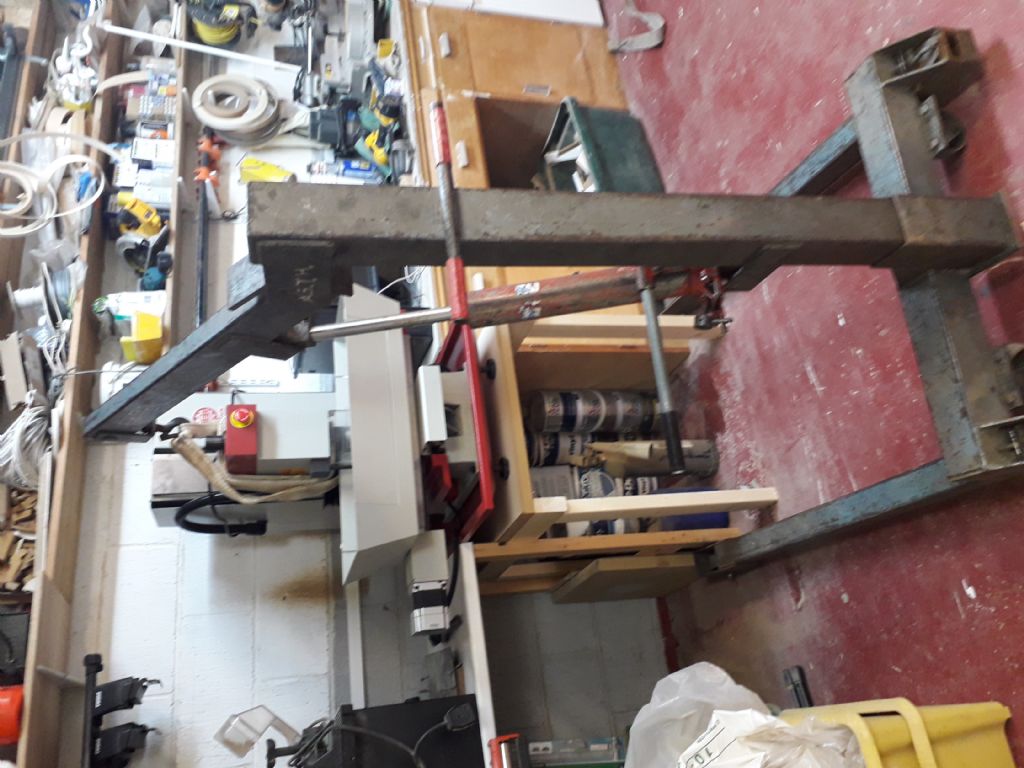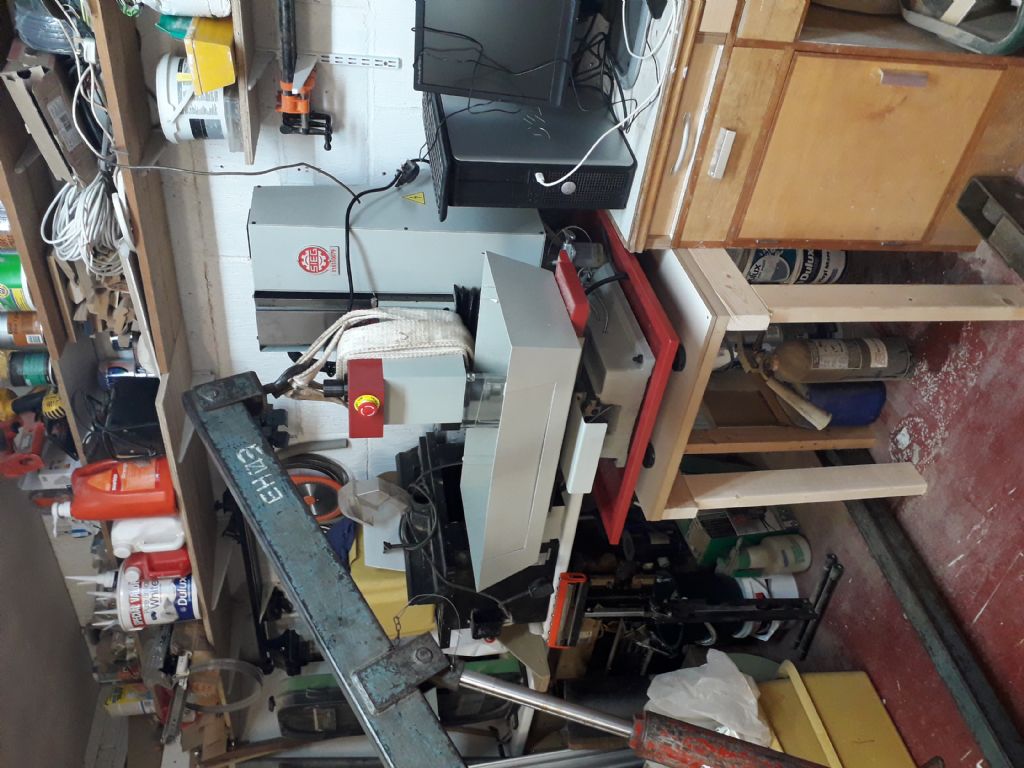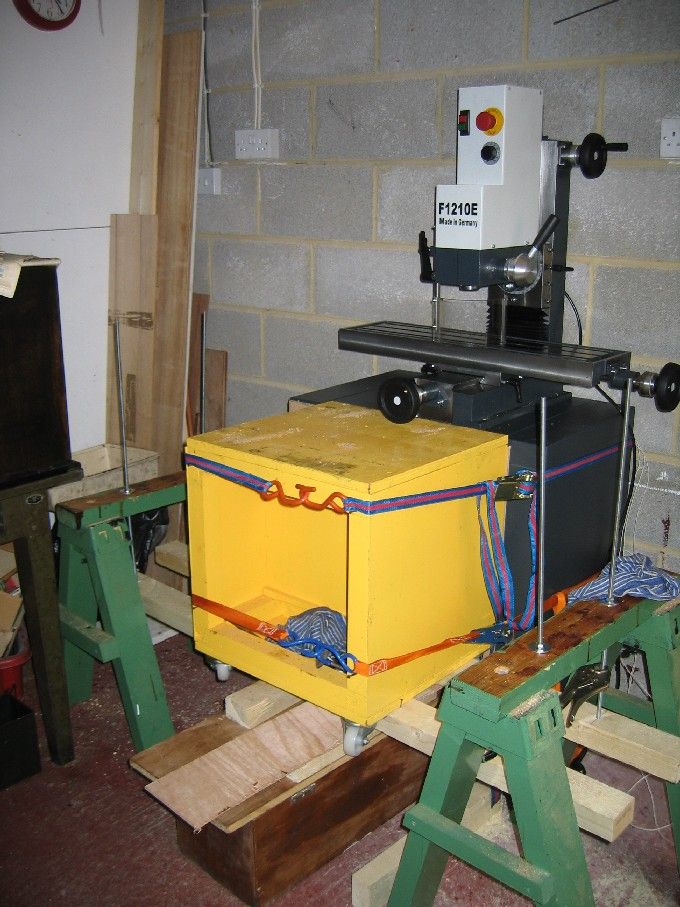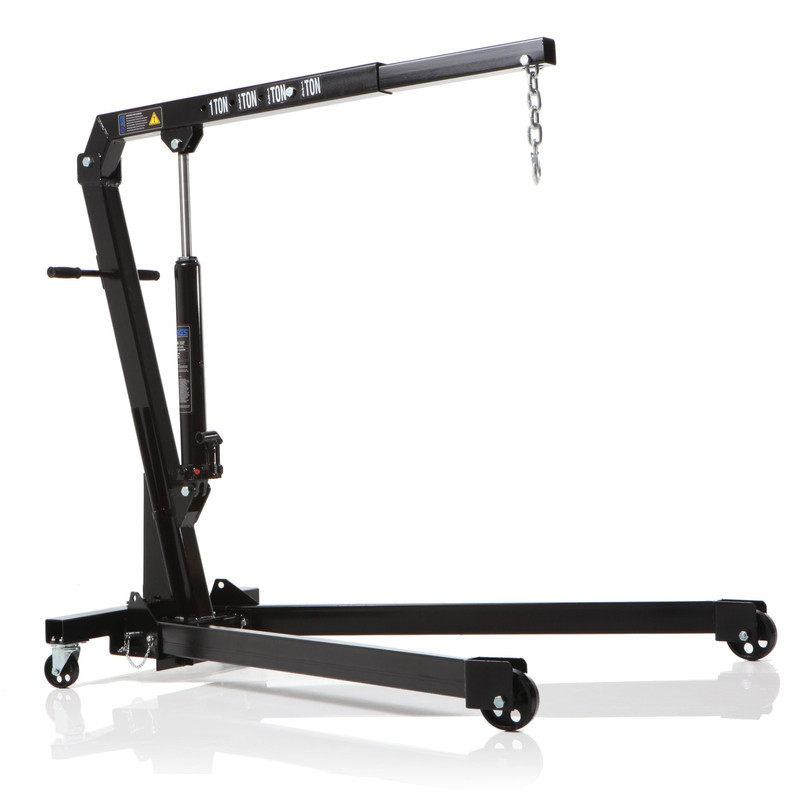Moving my new mill into place
| Kevin Murrell | 26/06/2023 21:58:46 |
| 59 forum posts 6 photos | Dear all No doubt an issue many have faced! My new mill (Sieg SX3.5) is arriving on a pallet soon. I need to mount it on the stand in my workshop/shed. I thought of an engine hoist, but surely the legs are going to get in the way? I suspect the shed ceiling wouldn't support a hoist? Is my best option finding three big lads and simply lifting it? Thanks in anticipation of some good tips! Kevin
|
| Pete Rimmer | 26/06/2023 22:11:03 |
| 1486 forum posts 105 photos | 150kg is only 50kg each for 3 good sized lads. |
| Bazyle | 26/06/2023 23:16:24 |
6956 forum posts 229 photos | If things are too congested for an engine crane it is rather unsafe for multiple people. One option if you have a straight run from the door to the bench is two scaffold planks to make a ramp. Using two makes balancing less risky. Use a hoist or jack to pull the lathe up the ramp. Have the lathe on a sheet of ply not rollers so it can't just roll down if you need to adjust the hoist. The extra friction is of no consequence if you have a good ratio on he hoist or jack. |
| Nigel Graham 2 | 26/06/2023 23:21:08 |
| 3293 forum posts 112 photos | I was faced with similar problems setting up my workshop after I'd moved home, and solved it by making lifting-frames with scaffolding tubes and clips to suspend lifting-tackle. if you use a hoist or block-and-tackle you need be sure where you can suspend the machine safely, and it is very dangerous to improvise things like lifting-slings unless you really know ropes and knots. An engine-crane may work but the usual sort with two splayed legs is a right cussed thing if you can't arrange a straight lift and push in. It depends on whether you have room to manoeuvre it, and the headroom given that the height of the lifting equipment between hook and load can be significant. It would seem your best bet is a manual lift provided all are reasonably tall and they know how to lift heavy weights properly and reasonably safely. (Many people do not!) Before you start, ensure as much working space as possible, no slip / trip hazards, nothing loose that can be knocked over or off a bench. |
| JasonB | 27/06/2023 06:55:57 |
25215 forum posts 3105 photos 1 articles | If it is the Sieg stand then they are narrower than th emill so the legs of an engine hoist should fit down each side and depending on the capacity of your hoist the boom should be able to be extended as you only need it fully retracted when lifting to th ehoist's full capacity. If you are using the stand then it is also possible to put the mill on the stand with it stood away from the ewall and then move the whole thing into place by walking or rolling it, just remember it will be top heavy. Other option is to take the column off the bed then the two parts become more manageable which is what I did with my other two Siegs.
Edited By JasonB on 27/06/2023 06:56:11 Edited By JasonB on 27/06/2023 06:59:08 |
| Howard Lewis | 27/06/2023 11:43:08 |
| 7227 forum posts 21 photos | If the worst comes to the worst, you can "Jack and pack" BUT, be very careful, small increments and ensure that it doesn't topple over, onto you or anything else. Howard |
| JA | 27/06/2023 13:52:50 |
1605 forum posts 83 photos | I lifted my milling machine by myself. I had a long think about the job and came to the following conclusions:
I chose the latter. I already had a very robust little wooden table on casters. The mill was slid out of the delivery van and onto the table. It was then bolted to the table. The milling machine table was put in position and bolted to the floor. The wooden table with mill was lifted using two wooden beams, two saw horses and 10mm studding, nuts and large diameter washers. The wooden table was strapped to the milling machine table for peace of mind. Eventually the mill was slid onto its table. It took most of a day. You need to plan everything very carefully before doing such a job. The one thing on your side is time. If you do not like the look of things you can stop and think. A friend moved an old Colchester lathe out of his workshop (an old bomb shelter), up a flight of eight steps and 20 yards across his garden by himself. Next day he did the reverse with his new lathe. While not being a millwright he did work closely with them at work. When asked what he used the answer was knowledge, rollers, stakes, block and tackle and shear legs. All the best with the move. JA Edited By JA on 27/06/2023 13:55:22 |
| Jelly | 27/06/2023 14:37:41 |
474 forum posts 103 photos | Posted by Bazyle on 26/06/2023 23:16:24:
If things are too congested for an engine crane it is rather unsafe for multiple people. One option if you have a straight run from the door to the bench is two scaffold planks to make a ramp. Using two makes balancing less risky. Use a hoist or jack to pull the lathe up the ramp. Have the lathe on a sheet of ply not rollers so it can't just roll down if you need to adjust the hoist. The extra friction is of no consequence if you have a good ratio on he hoist or jack. I think there are ways one could do a manual lift safely. Slinging the mill from beneath with a pair of short slings connected with a d-shackle and passing a stout bar or scaffold pole through allows you to get as many people as will fit in the space round it and for them all to have a good grip with no pinch hazards. Assuming the bench isn't too high, and the slings are short, four people lifting and a fifth person controlling the load to prevent swinging would be pretty safe, better still if that fifth person can have some blocks to hand they can slide under allowing the people lifting to reposition between the floor and full height to maximise lifting with their legs and avoid putting their core muscles under too much stress. . If going a manual route the important thing is that everyone knows their limits, knows proper lifting form, and keeps well within both. I remember having ergonomics training where they drilled into us that the oft quoted HSE guideline of 25Kg for a man and 20kg for a woman is based on average people of working age, and that it is perfectly acceptable for someone to lift more if they have a demonstrated ability to do so safely and it's been assessed, but it is also wholly unacceptable to ask someone to lift something they were uncomfortable with just because it was under the guideline number. If in doubt add more people. . Ramps do work really well, but setup is everything because there's a lot of inherent instability in using them. I would personally be inclined to use rollers or a thin sheet of metal to minimise the static friction, having had experiences where a load jerked violently on a ramp when it overcame friction and became unstable. But that then means you do need a progress capture mechanism or a winch/pulley system which can do the whole move in one go, and allows safe lowering. Hiring a Tirfor for the day would give all of that very nicely, and is usually pretty cheap. |
| Vic | 27/06/2023 15:52:47 |
| 3453 forum posts 23 photos | I don’t know where Jason got that engine hoist but mine is a lot wider than that and I only just managed to use it in my shed. If I had suitable welding gear I would have modified it to make it easier to move in tight spaces. Mine is like this and the legs are as long and wide as they look!
|
| Bill Phinn | 27/06/2023 17:49:09 |
| 1076 forum posts 129 photos | Posted by JA on 27/06/2023 13:52:50:The mill was slid out of the delivery van and onto the table. table.
Can you tell us how you achieved that bit, JA? It sounds very simple, but in practice persuading a delivery driver to pallet-truck a heavy, crated machine off his tailgate on to anything but solid ground is dependent on the driver being willing to perform what will be a comparatively more risky manoeuvre. In my own case, when I had my Warco WM18 delivered, I had a strong dolly waiting that I persuaded the driver to roll his pallet truck on to off the tailgate of his wagon. It wasn't an easy task for him (or me) at all, because the weight of the pallet truck and its cargo when leaving the tailgate only make contact initially with one side of the dolly, at which point things can get very unbalanced and hairy. The driver went above and beyond for me, but I'm not sure I'd be able to persuade every driver to do the same. |
| JA | 27/06/2023 18:52:45 |
1605 forum posts 83 photos | Bill I ordered the milling machine through a local dealer in machine tools who would charge for the delivery. Therefore I collected it with a friend who had a medium sized van. The height of the van floor was about the same as the wooden table. We must have separated the mill from its pallet at the dealer. My friend kept the pallet as payment. I wish I had taken more photos. It was about 18 years ago. JA
|
Please login to post a reply.
Want the latest issue of Model Engineer or Model Engineers' Workshop? Use our magazine locator links to find your nearest stockist!
Sign up to our newsletter and get a free digital issue.
You can unsubscribe at anytime. View our privacy policy at www.mortons.co.uk/privacy
- hemingway ball turner
04/07/2025 14:40:26 - *Oct 2023: FORUM MIGRATION TIMELINE*
05/10/2023 07:57:11 - Making ER11 collet chuck
05/10/2023 07:56:24 - What did you do today? 2023
05/10/2023 07:25:01 - Orrery
05/10/2023 06:00:41 - Wera hand-tools
05/10/2023 05:47:07 - New member
05/10/2023 04:40:11 - Problems with external pot on at1 vfd
05/10/2023 00:06:32 - Drain plug
04/10/2023 23:36:17 - digi phase converter for 10 machines.....
04/10/2023 23:13:48 - More Latest Posts...
- View All Topics
- Reeves** - Rebuilt Royal Scot by Martin Evans
by John Broughton
£300.00 - BRITANNIA 5" GAUGE James Perrier
by Jon Seabright 1
£2,500.00 - Drill Grinder - for restoration
by Nigel Graham 2
£0.00 - WARCO WM18 MILLING MACHINE
by Alex Chudley
£1,200.00 - MYFORD SUPER 7 LATHE
by Alex Chudley
£2,000.00 - More "For Sale" Ads...
- D1-3 backplate
by Michael Horley
Price Not Specified - fixed steady for a Colchester bantam mark1 800
by George Jervis
Price Not Specified - lbsc pansy
by JACK SIDEBOTHAM
Price Not Specified - Pratt Burnerd multifit chuck key.
by Tim Riome
Price Not Specified - BANDSAW BLADE WELDER
by HUGH
Price Not Specified - More "Wanted" Ads...
Do you want to contact the Model Engineer and Model Engineers' Workshop team?
You can contact us by phone, mail or email about the magazines including becoming a contributor, submitting reader's letters or making queries about articles. You can also get in touch about this website, advertising or other general issues.
Click THIS LINK for full contact details.
For subscription issues please see THIS LINK.
Model Engineer Magazine
- Percival Marshall
- M.E. History
- LittleLEC
- M.E. Clock
ME Workshop
- An Adcock
- & Shipley
- Horizontal
- Mill
Subscribe Now
- Great savings
- Delivered to your door
Pre-order your copy!
- Delivered to your doorstep!
- Free UK delivery!
















 Register
Register Log-in
Log-in


